Report on Global Consumer Behaviour: Vodafone's Household Decisions
VerifiedAdded on 2023/01/13
|10
|3153
|72
Report
AI Summary
This report provides an analysis of global consumer behaviour, focusing on household decision-making processes within the context of Vodafone, a multinational telecommunications organization. It begins with an introduction to consumer behaviour, defining it as the study of psychological, social, and physical actions involved in the purchase, use, and disposal of products and services. The report then explains what constitutes a household and its decision-making processes, highlighting how factors like family life cycle and children as decision-makers influence consumer choices. The main body critically evaluates the impact of two key influences on household consumer decision-making: family life cycle and children's roles in the decision-making process. The report utilizes Maslow's motivation need theory to explain consumer behavior. The report explores various stages of the family life cycle and their impact on consumption patterns, and concludes by summarizing the key findings and implications for businesses, particularly Vodafone, in understanding and catering to diverse consumer needs and behaviors.
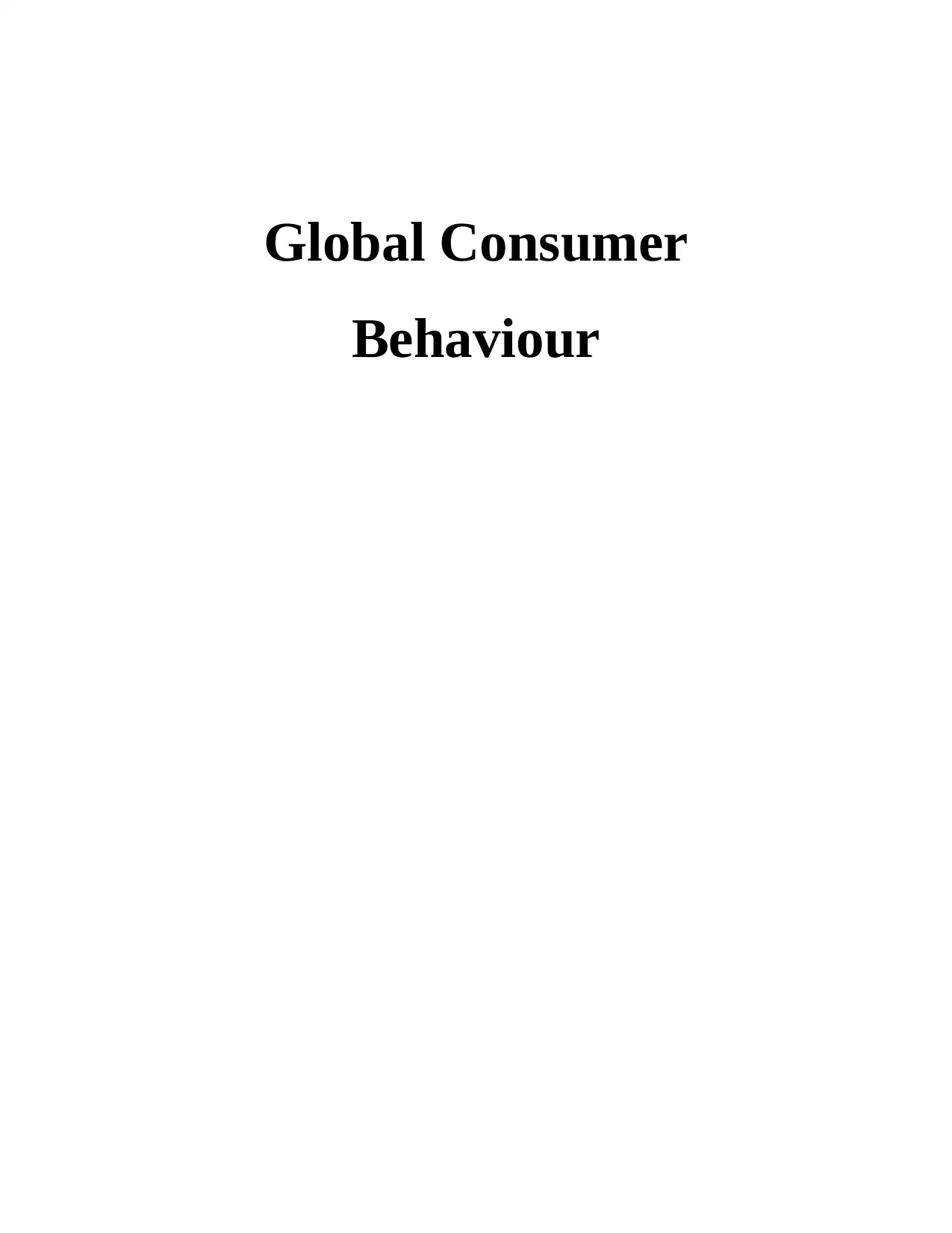
Global Consumer
Behaviour
Behaviour
Paraphrase This Document
Need a fresh take? Get an instant paraphrase of this document with our AI Paraphraser
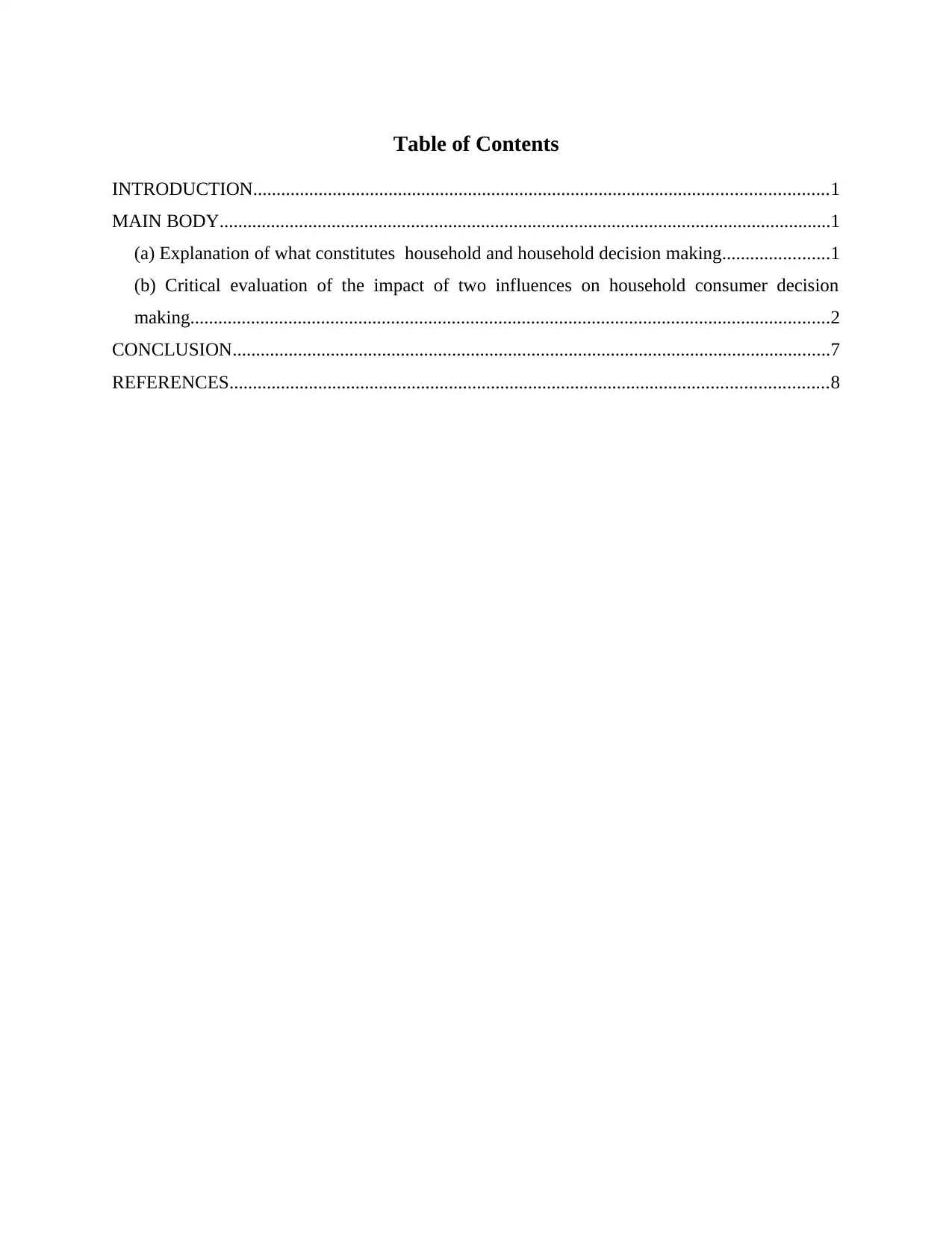
Table of Contents
INTRODUCTION...........................................................................................................................1
MAIN BODY...................................................................................................................................1
(a) Explanation of what constitutes household and household decision making.......................1
(b) Critical evaluation of the impact of two influences on household consumer decision
making.........................................................................................................................................2
CONCLUSION................................................................................................................................7
REFERENCES................................................................................................................................8
INTRODUCTION...........................................................................................................................1
MAIN BODY...................................................................................................................................1
(a) Explanation of what constitutes household and household decision making.......................1
(b) Critical evaluation of the impact of two influences on household consumer decision
making.........................................................................................................................................2
CONCLUSION................................................................................................................................7
REFERENCES................................................................................................................................8
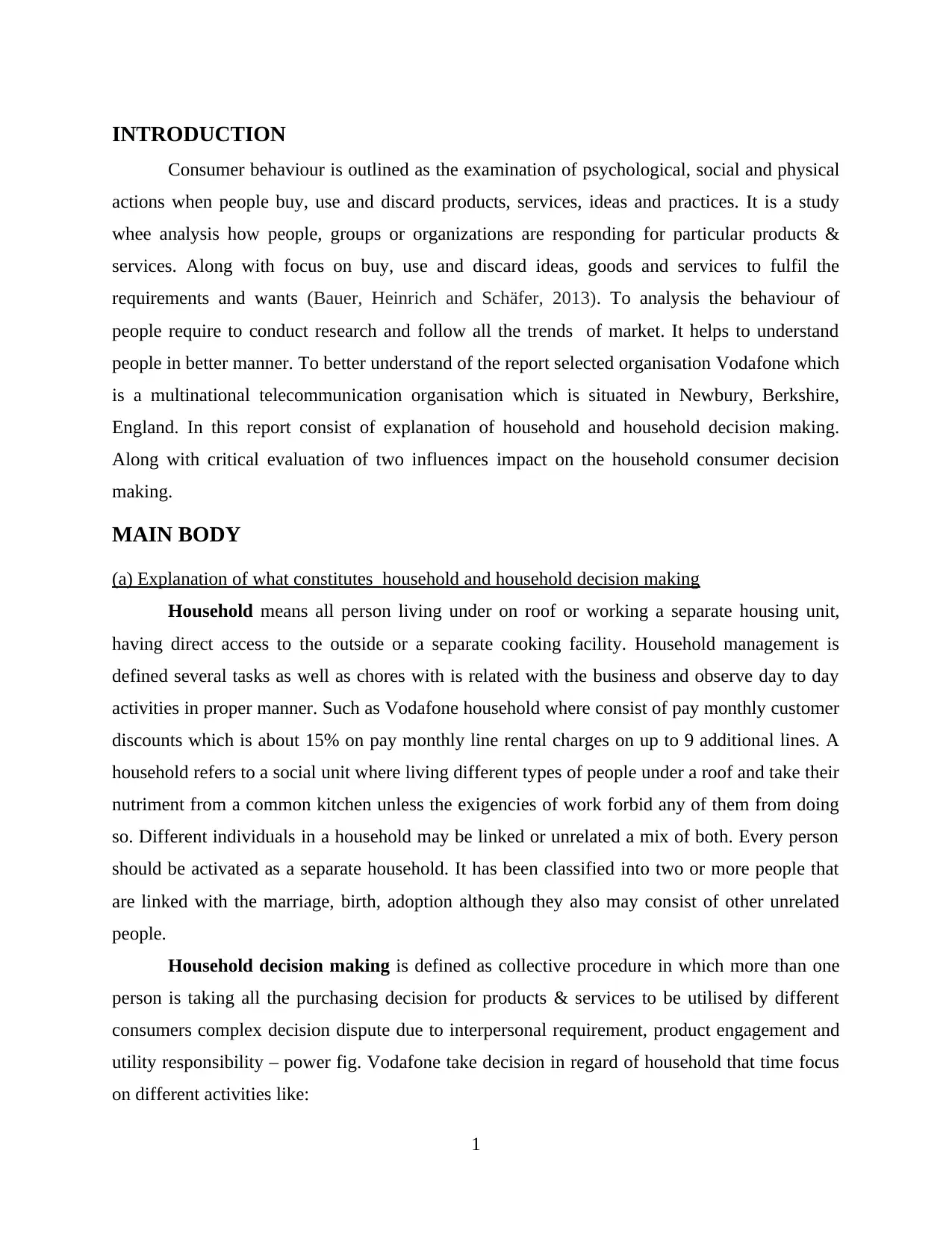
INTRODUCTION
Consumer behaviour is outlined as the examination of psychological, social and physical
actions when people buy, use and discard products, services, ideas and practices. It is a study
whee analysis how people, groups or organizations are responding for particular products &
services. Along with focus on buy, use and discard ideas, goods and services to fulfil the
requirements and wants (Bauer, Heinrich and Schäfer, 2013). To analysis the behaviour of
people require to conduct research and follow all the trends of market. It helps to understand
people in better manner. To better understand of the report selected organisation Vodafone which
is a multinational telecommunication organisation which is situated in Newbury, Berkshire,
England. In this report consist of explanation of household and household decision making.
Along with critical evaluation of two influences impact on the household consumer decision
making.
MAIN BODY
(a) Explanation of what constitutes household and household decision making
Household means all person living under on roof or working a separate housing unit,
having direct access to the outside or a separate cooking facility. Household management is
defined several tasks as well as chores with is related with the business and observe day to day
activities in proper manner. Such as Vodafone household where consist of pay monthly customer
discounts which is about 15% on pay monthly line rental charges on up to 9 additional lines. A
household refers to a social unit where living different types of people under a roof and take their
nutriment from a common kitchen unless the exigencies of work forbid any of them from doing
so. Different individuals in a household may be linked or unrelated a mix of both. Every person
should be activated as a separate household. It has been classified into two or more people that
are linked with the marriage, birth, adoption although they also may consist of other unrelated
people.
Household decision making is defined as collective procedure in which more than one
person is taking all the purchasing decision for products & services to be utilised by different
consumers complex decision dispute due to interpersonal requirement, product engagement and
utility responsibility – power fig. Vodafone take decision in regard of household that time focus
on different activities like:
1
Consumer behaviour is outlined as the examination of psychological, social and physical
actions when people buy, use and discard products, services, ideas and practices. It is a study
whee analysis how people, groups or organizations are responding for particular products &
services. Along with focus on buy, use and discard ideas, goods and services to fulfil the
requirements and wants (Bauer, Heinrich and Schäfer, 2013). To analysis the behaviour of
people require to conduct research and follow all the trends of market. It helps to understand
people in better manner. To better understand of the report selected organisation Vodafone which
is a multinational telecommunication organisation which is situated in Newbury, Berkshire,
England. In this report consist of explanation of household and household decision making.
Along with critical evaluation of two influences impact on the household consumer decision
making.
MAIN BODY
(a) Explanation of what constitutes household and household decision making
Household means all person living under on roof or working a separate housing unit,
having direct access to the outside or a separate cooking facility. Household management is
defined several tasks as well as chores with is related with the business and observe day to day
activities in proper manner. Such as Vodafone household where consist of pay monthly customer
discounts which is about 15% on pay monthly line rental charges on up to 9 additional lines. A
household refers to a social unit where living different types of people under a roof and take their
nutriment from a common kitchen unless the exigencies of work forbid any of them from doing
so. Different individuals in a household may be linked or unrelated a mix of both. Every person
should be activated as a separate household. It has been classified into two or more people that
are linked with the marriage, birth, adoption although they also may consist of other unrelated
people.
Household decision making is defined as collective procedure in which more than one
person is taking all the purchasing decision for products & services to be utilised by different
consumers complex decision dispute due to interpersonal requirement, product engagement and
utility responsibility – power fig. Vodafone take decision in regard of household that time focus
on different activities like:
1
⊘ This is a preview!⊘
Do you want full access?
Subscribe today to unlock all pages.

Trusted by 1+ million students worldwide
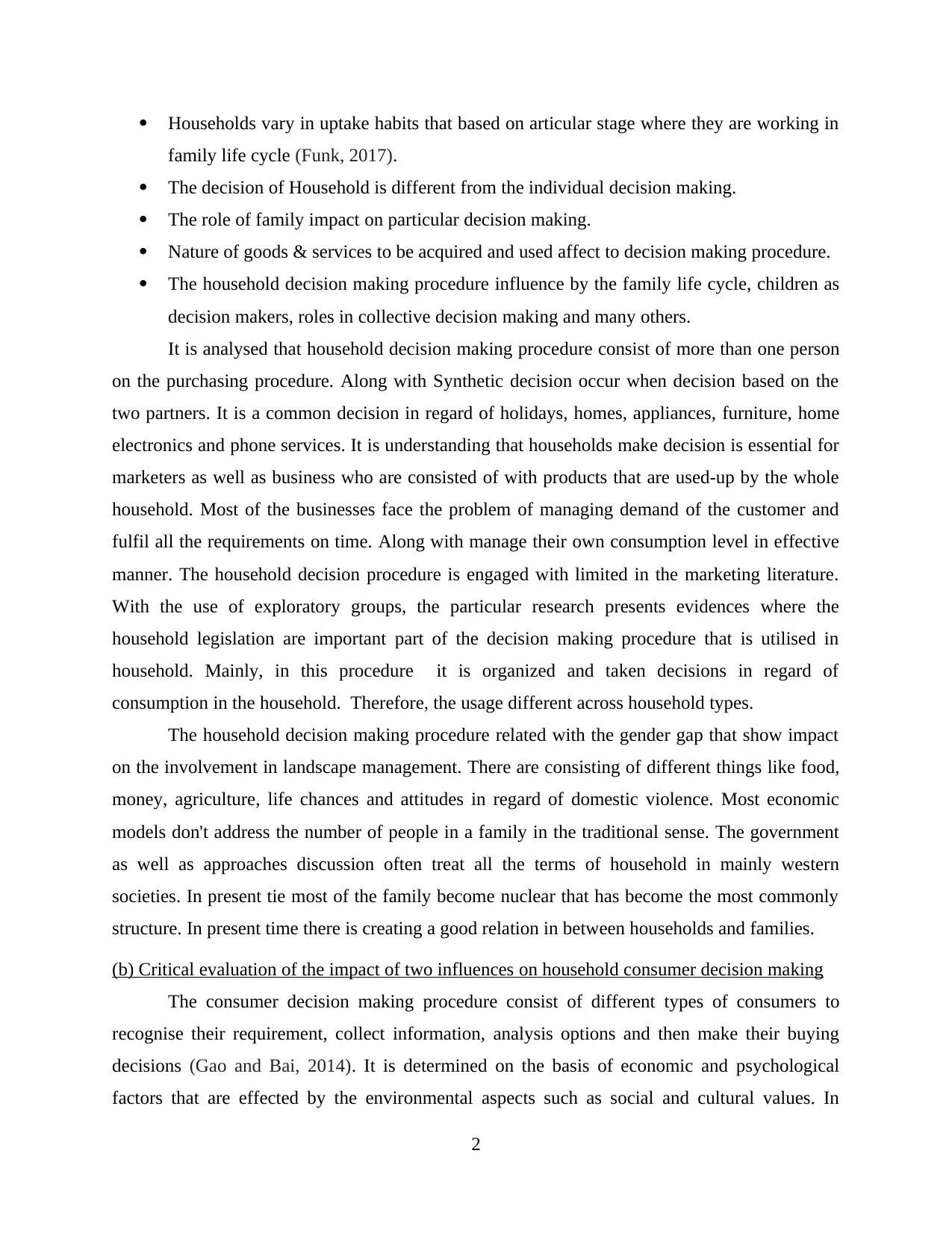
Households vary in uptake habits that based on articular stage where they are working in
family life cycle (Funk, 2017).
The decision of Household is different from the individual decision making.
The role of family impact on particular decision making.
Nature of goods & services to be acquired and used affect to decision making procedure.
The household decision making procedure influence by the family life cycle, children as
decision makers, roles in collective decision making and many others.
It is analysed that household decision making procedure consist of more than one person
on the purchasing procedure. Along with Synthetic decision occur when decision based on the
two partners. It is a common decision in regard of holidays, homes, appliances, furniture, home
electronics and phone services. It is understanding that households make decision is essential for
marketers as well as business who are consisted of with products that are used-up by the whole
household. Most of the businesses face the problem of managing demand of the customer and
fulfil all the requirements on time. Along with manage their own consumption level in effective
manner. The household decision procedure is engaged with limited in the marketing literature.
With the use of exploratory groups, the particular research presents evidences where the
household legislation are important part of the decision making procedure that is utilised in
household. Mainly, in this procedure it is organized and taken decisions in regard of
consumption in the household. Therefore, the usage different across household types.
The household decision making procedure related with the gender gap that show impact
on the involvement in landscape management. There are consisting of different things like food,
money, agriculture, life chances and attitudes in regard of domestic violence. Most economic
models don't address the number of people in a family in the traditional sense. The government
as well as approaches discussion often treat all the terms of household in mainly western
societies. In present tie most of the family become nuclear that has become the most commonly
structure. In present time there is creating a good relation in between households and families.
(b) Critical evaluation of the impact of two influences on household consumer decision making
The consumer decision making procedure consist of different types of consumers to
recognise their requirement, collect information, analysis options and then make their buying
decisions (Gao and Bai, 2014). It is determined on the basis of economic and psychological
factors that are effected by the environmental aspects such as social and cultural values. In
2
family life cycle (Funk, 2017).
The decision of Household is different from the individual decision making.
The role of family impact on particular decision making.
Nature of goods & services to be acquired and used affect to decision making procedure.
The household decision making procedure influence by the family life cycle, children as
decision makers, roles in collective decision making and many others.
It is analysed that household decision making procedure consist of more than one person
on the purchasing procedure. Along with Synthetic decision occur when decision based on the
two partners. It is a common decision in regard of holidays, homes, appliances, furniture, home
electronics and phone services. It is understanding that households make decision is essential for
marketers as well as business who are consisted of with products that are used-up by the whole
household. Most of the businesses face the problem of managing demand of the customer and
fulfil all the requirements on time. Along with manage their own consumption level in effective
manner. The household decision procedure is engaged with limited in the marketing literature.
With the use of exploratory groups, the particular research presents evidences where the
household legislation are important part of the decision making procedure that is utilised in
household. Mainly, in this procedure it is organized and taken decisions in regard of
consumption in the household. Therefore, the usage different across household types.
The household decision making procedure related with the gender gap that show impact
on the involvement in landscape management. There are consisting of different things like food,
money, agriculture, life chances and attitudes in regard of domestic violence. Most economic
models don't address the number of people in a family in the traditional sense. The government
as well as approaches discussion often treat all the terms of household in mainly western
societies. In present tie most of the family become nuclear that has become the most commonly
structure. In present time there is creating a good relation in between households and families.
(b) Critical evaluation of the impact of two influences on household consumer decision making
The consumer decision making procedure consist of different types of consumers to
recognise their requirement, collect information, analysis options and then make their buying
decisions (Gao and Bai, 2014). It is determined on the basis of economic and psychological
factors that are effected by the environmental aspects such as social and cultural values. In
2
Paraphrase This Document
Need a fresh take? Get an instant paraphrase of this document with our AI Paraphraser

addition, Household consumer means those who dwell cover same roof as a family as well as
utilize economic. There are defined a theory which is related with the consumer behaviour.
Motivation need theory: This theory was introduced by the Abraham Maslow which is put
forward their hierarchy of requirement in 1943, sending ripples impact by the whole
psychological gathering. According to this theory people act to fulfil the requirement that
depended on the five part priority system. There are consisting of importance of Psychological,
safety, esteem, love and self actualization. The Maslow theory direct impact on the consumer
behaviour because people wants to fulfil self esteem and through this theory motivate for
purchase products & services which related to basis needs & requirement (Gbadamosi, 2017).
Most of the businesses apply Maslow theory in order to explain requirement of customer and
how to invest amount in basis needs. Marketers have been able to apply motivational need theory
very effectively. In order to developing artificial requirement for consumer. There is analysis two
factors that impact on the household consumer decision making in direct manner such as:
Family life cycle: A family where the level of cohesion and discuss between the family
members is high, impact on the purchase decision making that are successful conformity to
keeping other's preferences in mind. In context of families where the affectionate attachment is
low between all the family members so it will impact on decision making procedure because
every person have own preferences in regard of products & services. The family life cycle is
linked with the extra time and acquirable for income, education and many others. At the
particular stages most of the families find them selves that impact on the nature of products and
services which they want and particular consumption patterns and magnitude of consumption on
particular products (Thangasamy and Patikar, 2014).
The family life cycle model define about the different stages in which users pass by their
lives when they have families. There are identified various variant of the classified on the stages
but mainly focused on the different stages where changeable behaviour face of people like at
bachelor stage, new married couple, empty nest and many others. The family life cycle is portion
of the division of targeting and positioning shape or even the consumer buying behaviour
examine as it concerns itself with different stages and generations of individual present within a
particular family and how to target them with marketing efforts (Klöckner, 2013). In case of joint
family there might be youngster, grand parents, uncles and aunts, parents and all in various sages
3
utilize economic. There are defined a theory which is related with the consumer behaviour.
Motivation need theory: This theory was introduced by the Abraham Maslow which is put
forward their hierarchy of requirement in 1943, sending ripples impact by the whole
psychological gathering. According to this theory people act to fulfil the requirement that
depended on the five part priority system. There are consisting of importance of Psychological,
safety, esteem, love and self actualization. The Maslow theory direct impact on the consumer
behaviour because people wants to fulfil self esteem and through this theory motivate for
purchase products & services which related to basis needs & requirement (Gbadamosi, 2017).
Most of the businesses apply Maslow theory in order to explain requirement of customer and
how to invest amount in basis needs. Marketers have been able to apply motivational need theory
very effectively. In order to developing artificial requirement for consumer. There is analysis two
factors that impact on the household consumer decision making in direct manner such as:
Family life cycle: A family where the level of cohesion and discuss between the family
members is high, impact on the purchase decision making that are successful conformity to
keeping other's preferences in mind. In context of families where the affectionate attachment is
low between all the family members so it will impact on decision making procedure because
every person have own preferences in regard of products & services. The family life cycle is
linked with the extra time and acquirable for income, education and many others. At the
particular stages most of the families find them selves that impact on the nature of products and
services which they want and particular consumption patterns and magnitude of consumption on
particular products (Thangasamy and Patikar, 2014).
The family life cycle model define about the different stages in which users pass by their
lives when they have families. There are identified various variant of the classified on the stages
but mainly focused on the different stages where changeable behaviour face of people like at
bachelor stage, new married couple, empty nest and many others. The family life cycle is portion
of the division of targeting and positioning shape or even the consumer buying behaviour
examine as it concerns itself with different stages and generations of individual present within a
particular family and how to target them with marketing efforts (Klöckner, 2013). In case of joint
family there might be youngster, grand parents, uncles and aunts, parents and all in various sages
3
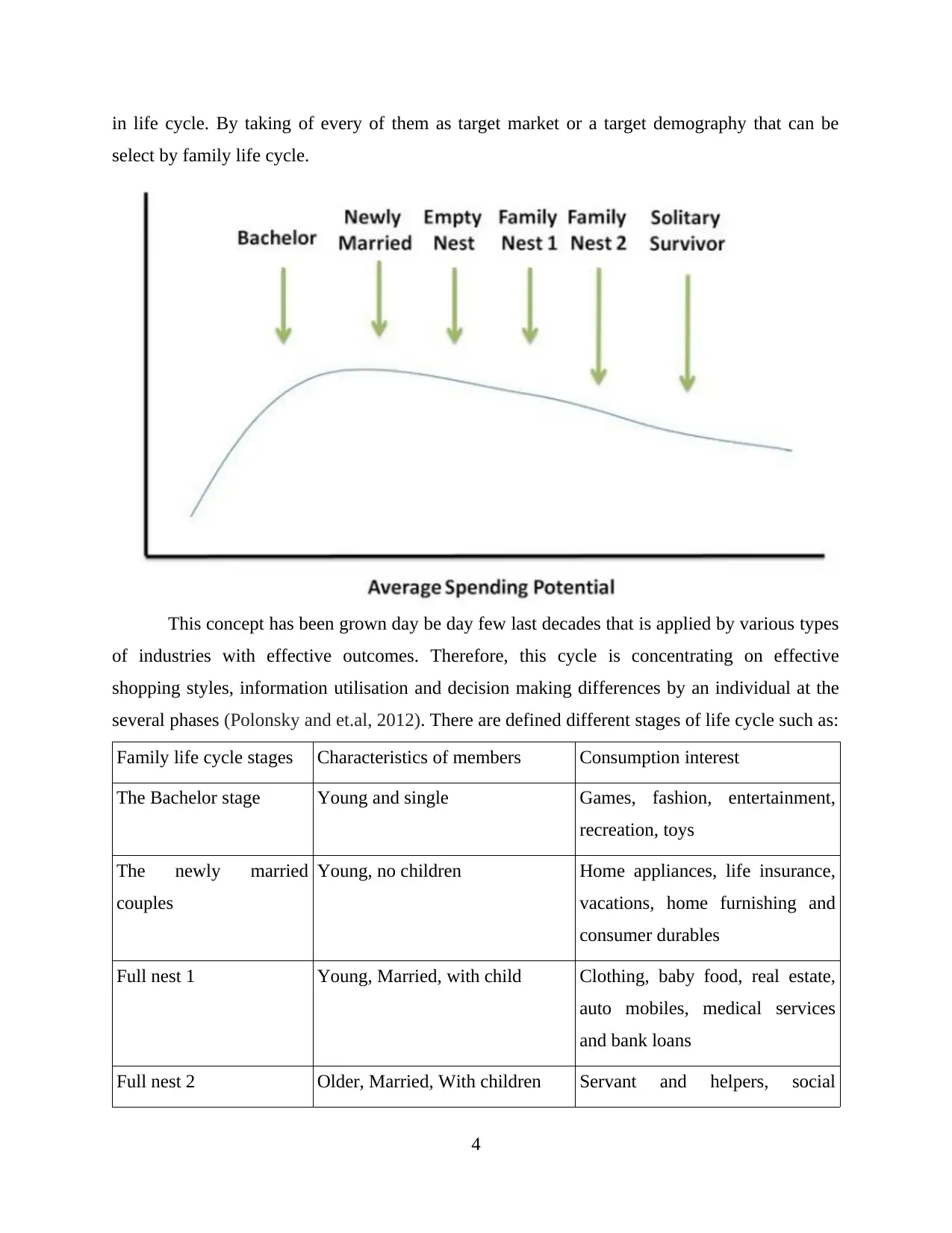
in life cycle. By taking of every of them as target market or a target demography that can be
select by family life cycle.
This concept has been grown day be day few last decades that is applied by various types
of industries with effective outcomes. Therefore, this cycle is concentrating on effective
shopping styles, information utilisation and decision making differences by an individual at the
several phases (Polonsky and et.al, 2012). There are defined different stages of life cycle such as:
Family life cycle stages Characteristics of members Consumption interest
The Bachelor stage Young and single Games, fashion, entertainment,
recreation, toys
The newly married
couples
Young, no children Home appliances, life insurance,
vacations, home furnishing and
consumer durables
Full nest 1 Young, Married, with child Clothing, baby food, real estate,
auto mobiles, medical services
and bank loans
Full nest 2 Older, Married, With children Servant and helpers, social
4
select by family life cycle.
This concept has been grown day be day few last decades that is applied by various types
of industries with effective outcomes. Therefore, this cycle is concentrating on effective
shopping styles, information utilisation and decision making differences by an individual at the
several phases (Polonsky and et.al, 2012). There are defined different stages of life cycle such as:
Family life cycle stages Characteristics of members Consumption interest
The Bachelor stage Young and single Games, fashion, entertainment,
recreation, toys
The newly married
couples
Young, no children Home appliances, life insurance,
vacations, home furnishing and
consumer durables
Full nest 1 Young, Married, with child Clothing, baby food, real estate,
auto mobiles, medical services
and bank loans
Full nest 2 Older, Married, With children Servant and helpers, social
4
⊘ This is a preview!⊘
Do you want full access?
Subscribe today to unlock all pages.

Trusted by 1+ million students worldwide
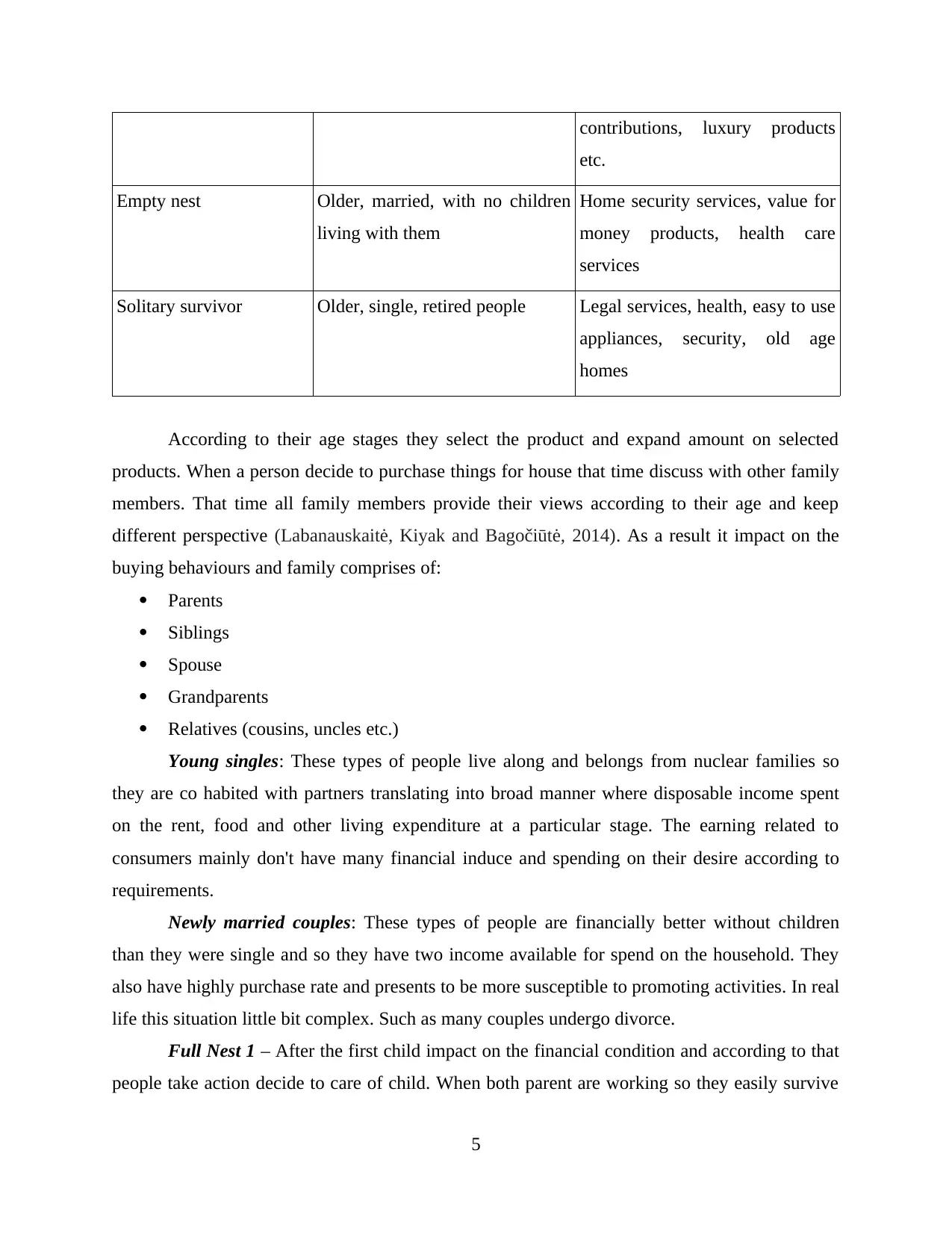
contributions, luxury products
etc.
Empty nest Older, married, with no children
living with them
Home security services, value for
money products, health care
services
Solitary survivor Older, single, retired people Legal services, health, easy to use
appliances, security, old age
homes
According to their age stages they select the product and expand amount on selected
products. When a person decide to purchase things for house that time discuss with other family
members. That time all family members provide their views according to their age and keep
different perspective (Labanauskaitė, Kiyak and Bagočiūtė, 2014). As a result it impact on the
buying behaviours and family comprises of:
Parents
Siblings
Spouse
Grandparents
Relatives (cousins, uncles etc.)
Young singles: These types of people live along and belongs from nuclear families so
they are co habited with partners translating into broad manner where disposable income spent
on the rent, food and other living expenditure at a particular stage. The earning related to
consumers mainly don't have many financial induce and spending on their desire according to
requirements.
Newly married couples: These types of people are financially better without children
than they were single and so they have two income available for spend on the household. They
also have highly purchase rate and presents to be more susceptible to promoting activities. In real
life this situation little bit complex. Such as many couples undergo divorce.
Full Nest 1 – After the first child impact on the financial condition and according to that
people take action decide to care of child. When both parent are working so they easily survive
5
etc.
Empty nest Older, married, with no children
living with them
Home security services, value for
money products, health care
services
Solitary survivor Older, single, retired people Legal services, health, easy to use
appliances, security, old age
homes
According to their age stages they select the product and expand amount on selected
products. When a person decide to purchase things for house that time discuss with other family
members. That time all family members provide their views according to their age and keep
different perspective (Labanauskaitė, Kiyak and Bagočiūtė, 2014). As a result it impact on the
buying behaviours and family comprises of:
Parents
Siblings
Spouse
Grandparents
Relatives (cousins, uncles etc.)
Young singles: These types of people live along and belongs from nuclear families so
they are co habited with partners translating into broad manner where disposable income spent
on the rent, food and other living expenditure at a particular stage. The earning related to
consumers mainly don't have many financial induce and spending on their desire according to
requirements.
Newly married couples: These types of people are financially better without children
than they were single and so they have two income available for spend on the household. They
also have highly purchase rate and presents to be more susceptible to promoting activities. In real
life this situation little bit complex. Such as many couples undergo divorce.
Full Nest 1 – After the first child impact on the financial condition and according to that
people take action decide to care of child. When both parent are working so they easily survive
5
Paraphrase This Document
Need a fresh take? Get an instant paraphrase of this document with our AI Paraphraser
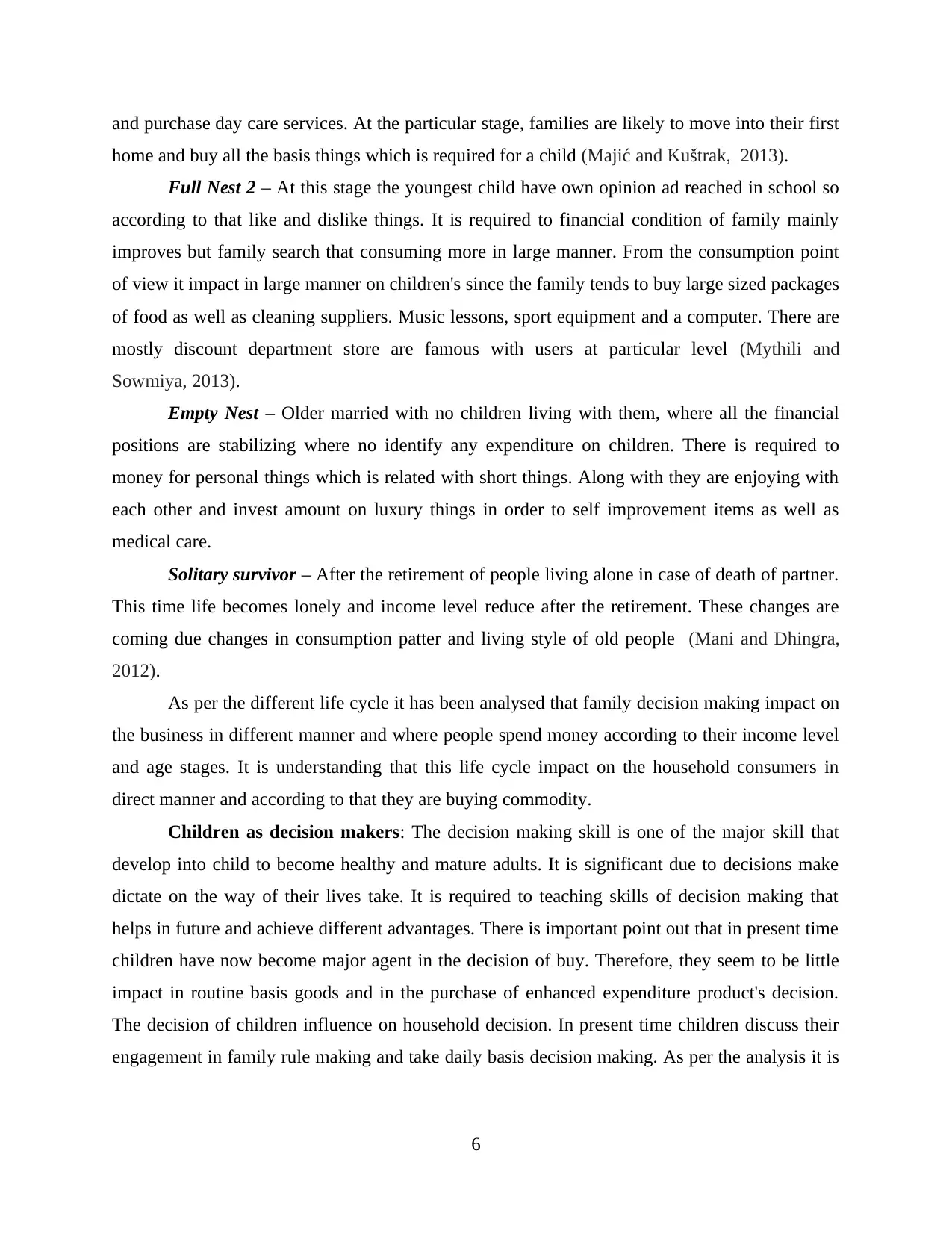
and purchase day care services. At the particular stage, families are likely to move into their first
home and buy all the basis things which is required for a child (Majić and Kuštrak, 2013).
Full Nest 2 – At this stage the youngest child have own opinion ad reached in school so
according to that like and dislike things. It is required to financial condition of family mainly
improves but family search that consuming more in large manner. From the consumption point
of view it impact in large manner on children's since the family tends to buy large sized packages
of food as well as cleaning suppliers. Music lessons, sport equipment and a computer. There are
mostly discount department store are famous with users at particular level (Mythili and
Sowmiya, 2013).
Empty Nest – Older married with no children living with them, where all the financial
positions are stabilizing where no identify any expenditure on children. There is required to
money for personal things which is related with short things. Along with they are enjoying with
each other and invest amount on luxury things in order to self improvement items as well as
medical care.
Solitary survivor – After the retirement of people living alone in case of death of partner.
This time life becomes lonely and income level reduce after the retirement. These changes are
coming due changes in consumption patter and living style of old people (Mani and Dhingra,
2012).
As per the different life cycle it has been analysed that family decision making impact on
the business in different manner and where people spend money according to their income level
and age stages. It is understanding that this life cycle impact on the household consumers in
direct manner and according to that they are buying commodity.
Children as decision makers: The decision making skill is one of the major skill that
develop into child to become healthy and mature adults. It is significant due to decisions make
dictate on the way of their lives take. It is required to teaching skills of decision making that
helps in future and achieve different advantages. There is important point out that in present time
children have now become major agent in the decision of buy. Therefore, they seem to be little
impact in routine basis goods and in the purchase of enhanced expenditure product's decision.
The decision of children influence on household decision. In present time children discuss their
engagement in family rule making and take daily basis decision making. As per the analysis it is
6
home and buy all the basis things which is required for a child (Majić and Kuštrak, 2013).
Full Nest 2 – At this stage the youngest child have own opinion ad reached in school so
according to that like and dislike things. It is required to financial condition of family mainly
improves but family search that consuming more in large manner. From the consumption point
of view it impact in large manner on children's since the family tends to buy large sized packages
of food as well as cleaning suppliers. Music lessons, sport equipment and a computer. There are
mostly discount department store are famous with users at particular level (Mythili and
Sowmiya, 2013).
Empty Nest – Older married with no children living with them, where all the financial
positions are stabilizing where no identify any expenditure on children. There is required to
money for personal things which is related with short things. Along with they are enjoying with
each other and invest amount on luxury things in order to self improvement items as well as
medical care.
Solitary survivor – After the retirement of people living alone in case of death of partner.
This time life becomes lonely and income level reduce after the retirement. These changes are
coming due changes in consumption patter and living style of old people (Mani and Dhingra,
2012).
As per the different life cycle it has been analysed that family decision making impact on
the business in different manner and where people spend money according to their income level
and age stages. It is understanding that this life cycle impact on the household consumers in
direct manner and according to that they are buying commodity.
Children as decision makers: The decision making skill is one of the major skill that
develop into child to become healthy and mature adults. It is significant due to decisions make
dictate on the way of their lives take. It is required to teaching skills of decision making that
helps in future and achieve different advantages. There is important point out that in present time
children have now become major agent in the decision of buy. Therefore, they seem to be little
impact in routine basis goods and in the purchase of enhanced expenditure product's decision.
The decision of children influence on household decision. In present time children discuss their
engagement in family rule making and take daily basis decision making. As per the analysis it is
6
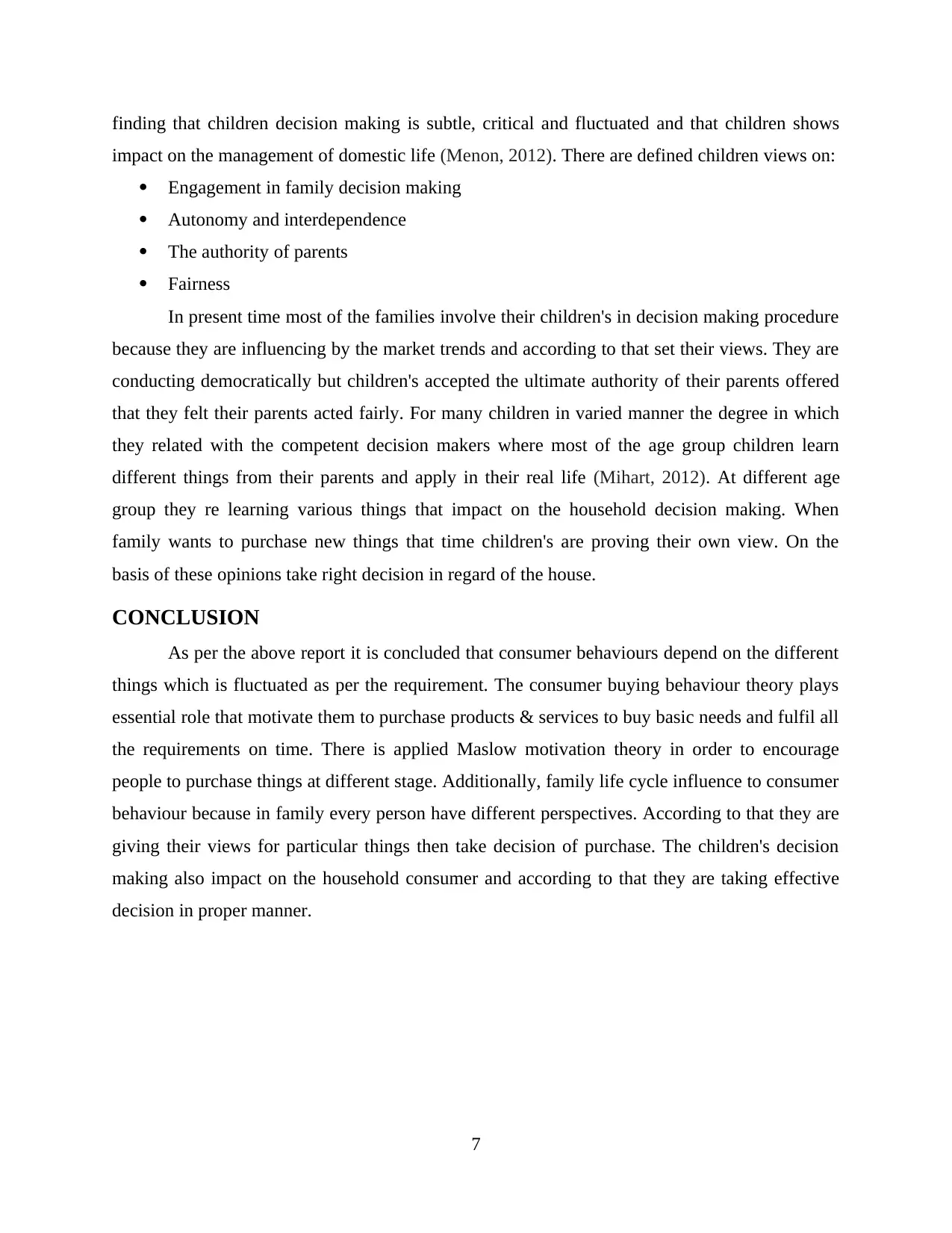
finding that children decision making is subtle, critical and fluctuated and that children shows
impact on the management of domestic life (Menon, 2012). There are defined children views on:
Engagement in family decision making
Autonomy and interdependence
The authority of parents
Fairness
In present time most of the families involve their children's in decision making procedure
because they are influencing by the market trends and according to that set their views. They are
conducting democratically but children's accepted the ultimate authority of their parents offered
that they felt their parents acted fairly. For many children in varied manner the degree in which
they related with the competent decision makers where most of the age group children learn
different things from their parents and apply in their real life (Mihart, 2012). At different age
group they re learning various things that impact on the household decision making. When
family wants to purchase new things that time children's are proving their own view. On the
basis of these opinions take right decision in regard of the house.
CONCLUSION
As per the above report it is concluded that consumer behaviours depend on the different
things which is fluctuated as per the requirement. The consumer buying behaviour theory plays
essential role that motivate them to purchase products & services to buy basic needs and fulfil all
the requirements on time. There is applied Maslow motivation theory in order to encourage
people to purchase things at different stage. Additionally, family life cycle influence to consumer
behaviour because in family every person have different perspectives. According to that they are
giving their views for particular things then take decision of purchase. The children's decision
making also impact on the household consumer and according to that they are taking effective
decision in proper manner.
7
impact on the management of domestic life (Menon, 2012). There are defined children views on:
Engagement in family decision making
Autonomy and interdependence
The authority of parents
Fairness
In present time most of the families involve their children's in decision making procedure
because they are influencing by the market trends and according to that set their views. They are
conducting democratically but children's accepted the ultimate authority of their parents offered
that they felt their parents acted fairly. For many children in varied manner the degree in which
they related with the competent decision makers where most of the age group children learn
different things from their parents and apply in their real life (Mihart, 2012). At different age
group they re learning various things that impact on the household decision making. When
family wants to purchase new things that time children's are proving their own view. On the
basis of these opinions take right decision in regard of the house.
CONCLUSION
As per the above report it is concluded that consumer behaviours depend on the different
things which is fluctuated as per the requirement. The consumer buying behaviour theory plays
essential role that motivate them to purchase products & services to buy basic needs and fulfil all
the requirements on time. There is applied Maslow motivation theory in order to encourage
people to purchase things at different stage. Additionally, family life cycle influence to consumer
behaviour because in family every person have different perspectives. According to that they are
giving their views for particular things then take decision of purchase. The children's decision
making also impact on the household consumer and according to that they are taking effective
decision in proper manner.
7
⊘ This is a preview!⊘
Do you want full access?
Subscribe today to unlock all pages.

Trusted by 1+ million students worldwide
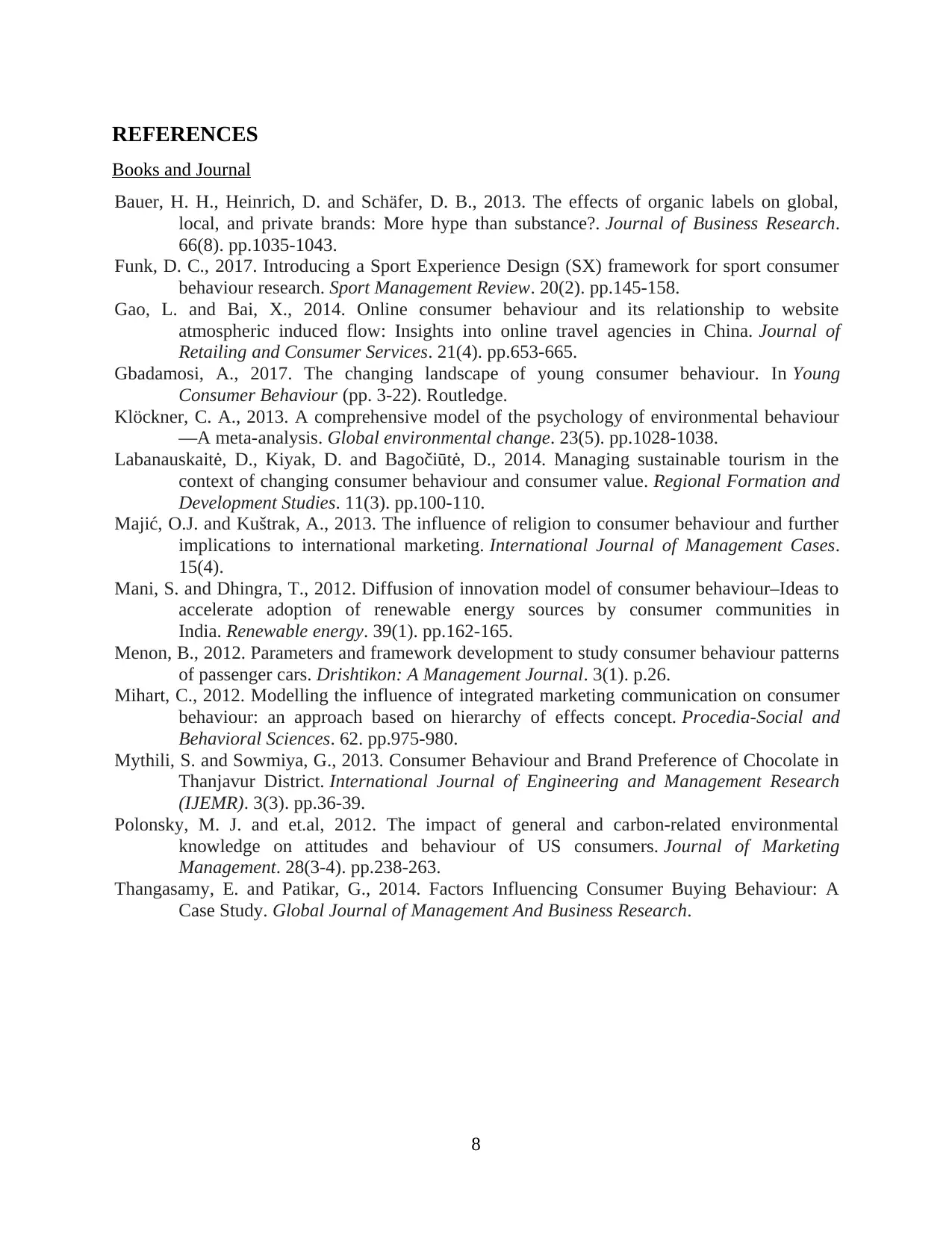
REFERENCES
Books and Journal
Bauer, H. H., Heinrich, D. and Schäfer, D. B., 2013. The effects of organic labels on global,
local, and private brands: More hype than substance?. Journal of Business Research.
66(8). pp.1035-1043.
Funk, D. C., 2017. Introducing a Sport Experience Design (SX) framework for sport consumer
behaviour research. Sport Management Review. 20(2). pp.145-158.
Gao, L. and Bai, X., 2014. Online consumer behaviour and its relationship to website
atmospheric induced flow: Insights into online travel agencies in China. Journal of
Retailing and Consumer Services. 21(4). pp.653-665.
Gbadamosi, A., 2017. The changing landscape of young consumer behaviour. In Young
Consumer Behaviour (pp. 3-22). Routledge.
Klöckner, C. A., 2013. A comprehensive model of the psychology of environmental behaviour
—A meta-analysis. Global environmental change. 23(5). pp.1028-1038.
Labanauskaitė, D., Kiyak, D. and Bagočiūtė, D., 2014. Managing sustainable tourism in the
context of changing consumer behaviour and consumer value. Regional Formation and
Development Studies. 11(3). pp.100-110.
Majić, O.J. and Kuštrak, A., 2013. The influence of religion to consumer behaviour and further
implications to international marketing. International Journal of Management Cases.
15(4).
Mani, S. and Dhingra, T., 2012. Diffusion of innovation model of consumer behaviour–Ideas to
accelerate adoption of renewable energy sources by consumer communities in
India. Renewable energy. 39(1). pp.162-165.
Menon, B., 2012. Parameters and framework development to study consumer behaviour patterns
of passenger cars. Drishtikon: A Management Journal. 3(1). p.26.
Mihart, C., 2012. Modelling the influence of integrated marketing communication on consumer
behaviour: an approach based on hierarchy of effects concept. Procedia-Social and
Behavioral Sciences. 62. pp.975-980.
Mythili, S. and Sowmiya, G., 2013. Consumer Behaviour and Brand Preference of Chocolate in
Thanjavur District. International Journal of Engineering and Management Research
(IJEMR). 3(3). pp.36-39.
Polonsky, M. J. and et.al, 2012. The impact of general and carbon-related environmental
knowledge on attitudes and behaviour of US consumers. Journal of Marketing
Management. 28(3-4). pp.238-263.
Thangasamy, E. and Patikar, G., 2014. Factors Influencing Consumer Buying Behaviour: A
Case Study. Global Journal of Management And Business Research.
8
Books and Journal
Bauer, H. H., Heinrich, D. and Schäfer, D. B., 2013. The effects of organic labels on global,
local, and private brands: More hype than substance?. Journal of Business Research.
66(8). pp.1035-1043.
Funk, D. C., 2017. Introducing a Sport Experience Design (SX) framework for sport consumer
behaviour research. Sport Management Review. 20(2). pp.145-158.
Gao, L. and Bai, X., 2014. Online consumer behaviour and its relationship to website
atmospheric induced flow: Insights into online travel agencies in China. Journal of
Retailing and Consumer Services. 21(4). pp.653-665.
Gbadamosi, A., 2017. The changing landscape of young consumer behaviour. In Young
Consumer Behaviour (pp. 3-22). Routledge.
Klöckner, C. A., 2013. A comprehensive model of the psychology of environmental behaviour
—A meta-analysis. Global environmental change. 23(5). pp.1028-1038.
Labanauskaitė, D., Kiyak, D. and Bagočiūtė, D., 2014. Managing sustainable tourism in the
context of changing consumer behaviour and consumer value. Regional Formation and
Development Studies. 11(3). pp.100-110.
Majić, O.J. and Kuštrak, A., 2013. The influence of religion to consumer behaviour and further
implications to international marketing. International Journal of Management Cases.
15(4).
Mani, S. and Dhingra, T., 2012. Diffusion of innovation model of consumer behaviour–Ideas to
accelerate adoption of renewable energy sources by consumer communities in
India. Renewable energy. 39(1). pp.162-165.
Menon, B., 2012. Parameters and framework development to study consumer behaviour patterns
of passenger cars. Drishtikon: A Management Journal. 3(1). p.26.
Mihart, C., 2012. Modelling the influence of integrated marketing communication on consumer
behaviour: an approach based on hierarchy of effects concept. Procedia-Social and
Behavioral Sciences. 62. pp.975-980.
Mythili, S. and Sowmiya, G., 2013. Consumer Behaviour and Brand Preference of Chocolate in
Thanjavur District. International Journal of Engineering and Management Research
(IJEMR). 3(3). pp.36-39.
Polonsky, M. J. and et.al, 2012. The impact of general and carbon-related environmental
knowledge on attitudes and behaviour of US consumers. Journal of Marketing
Management. 28(3-4). pp.238-263.
Thangasamy, E. and Patikar, G., 2014. Factors Influencing Consumer Buying Behaviour: A
Case Study. Global Journal of Management And Business Research.
8
1 out of 10
Related Documents
Your All-in-One AI-Powered Toolkit for Academic Success.
+13062052269
info@desklib.com
Available 24*7 on WhatsApp / Email
![[object Object]](/_next/static/media/star-bottom.7253800d.svg)
Unlock your academic potential
Copyright © 2020–2025 A2Z Services. All Rights Reserved. Developed and managed by ZUCOL.





